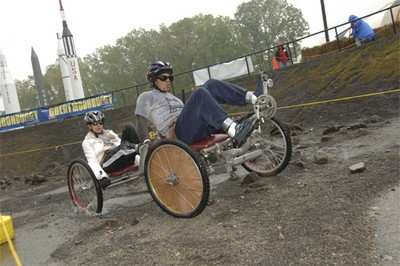To Be held in Huntsville, Ala., April 4-5
 Each year around this time, John
Tripp walks across a lunar surface, pondering the challenges ahead
for explorers brave enough to take on its cratered terrain. For
now, his "moon" is a winding ribbon of cement footpaths looped
around Huntsville's famed U.S. Space and Rocket Center, where Tripp
is a construction foreman.
Each year around this time, John
Tripp walks across a lunar surface, pondering the challenges ahead
for explorers brave enough to take on its cratered terrain. For
now, his "moon" is a winding ribbon of cement footpaths looped
around Huntsville's famed U.S. Space and Rocket Center, where Tripp
is a construction foreman.
By month's end, a half-mile of the paths will be transformed
into a harsh lunar landscape that will test the engineering savvy
and physical endurance of about 400 high school and college
students on 68 teams converging here April 4-5 for NASA's 15th
annual Great Moonbuggy Race. The event is organized by NASA's
Marshall Space Flight Center in Huntsville.
The students, hailing from 20 states, Puerto Rico, Canada, India
and Germany, are coming to race lightweight moonbuggies they
designed, based on the original lunar rovers first used during the
Apollo 15 moon mission in 1971. Tripp's construction team will
greet them with 17 unique course obstacles, built of plywood and
old tires, and covered with 20 tons of gravel and 5 tons of sand.
All of it will be reshaped into moon-like ridges, craters, sandy
basins and lava-etched "rilles."
The course was designed in 1993 by Dr. Larry Taylor, a lunar
geologist at the University of Tennessee at Knoxville, Dr. J.M.
Wersinger, a physics professor at Auburn University in Auburn,
Ala., and Marshall's University Affairs Officer Dr. Frank Six. It
proved so challenging that race planners began adding hay bales for
added safety; about 175 bales will line the course this year. Even
so, seatbelts are a requirement.
The students appear ready for the challenge. For two days, their
vehicles will brave the course against the backdrop of some of
America's most famous rockets and space vehicles. Cheered on by
hundreds of friends and spectators, they'll vie for cash prizes and
trophies awarded by NASA and corporate sponsors.

Each moonbuggy starts the competition disassembled and folded
for transport -- like the actual rovers flown to the moon in the
early 1970s. Each buggy must fit into a space no larger than 4 feet
in width, height and length. It must be carried in "collapsed" mode
to the starting line, assembled, then checked for all required
parts -- fenders, a flag and simulated hardware, including
batteries, a communications antenna, radio and TV camera.
Then, they're off. Each rover is piloted by two students: one
male, one female. The buggies race against the clock instead of
each other. Drivers push hard to conquer each obstacle without
exceeding the race's 15-minute time limit -- a new rule in
2008.

Tripp keeps the moonbuggy course safe, but tough. As the person
in charge of the course for the past 13 years, he's made a science
of getting the right blend of sand and rock, and building the right
combinations of steep and shallow features. He has to stay sharp,
he said, because student builders grow ever more sophisticated,
refining their designs from year to year to field sturdier buggies.
The schools also consult with each another. Veterans compare
concepts and give new teams free insight.
"That camaraderie is exciting to see," says Tammy Rowan, manager
of Marshall's Academic Affairs Office, which organizes the race
each year. "The race doesn't just pit schools against one another.
It's a shared experience for students who love math, science and
engineering. We hope it shows them the community and partnership
that awaits them in these career fields, and provides practical,
hands-on experience to reinforce their class work."

Tripp admits he enjoys making the experience a true challenge.
His course never fails to keep the pit crews in NASA's repairs tent
busy on race day – welding snapped struts, and replacing bent
wheels and sprockets. But most teams push through and Tripp likes
that too.
"Some of them reach the end and just fall over exhausted," Tripp
said. "But they get there. That's what it's all about."
 Airbus Racer Helicopter Demonstrator First Flight Part of Clean Sky 2 Initiative
Airbus Racer Helicopter Demonstrator First Flight Part of Clean Sky 2 Initiative Diamond's Electric DA40 Finds Fans at Dübendorf
Diamond's Electric DA40 Finds Fans at Dübendorf ANN's Daily Aero-Term (04.23.24): Line Up And Wait (LUAW)
ANN's Daily Aero-Term (04.23.24): Line Up And Wait (LUAW) NTSB Final Report: Extra Flugzeugbau GMBH EA300/L
NTSB Final Report: Extra Flugzeugbau GMBH EA300/L Classic Aero-TV: 'Never Give Up' - Advice From Two of FedEx's Female Captains
Classic Aero-TV: 'Never Give Up' - Advice From Two of FedEx's Female Captains






